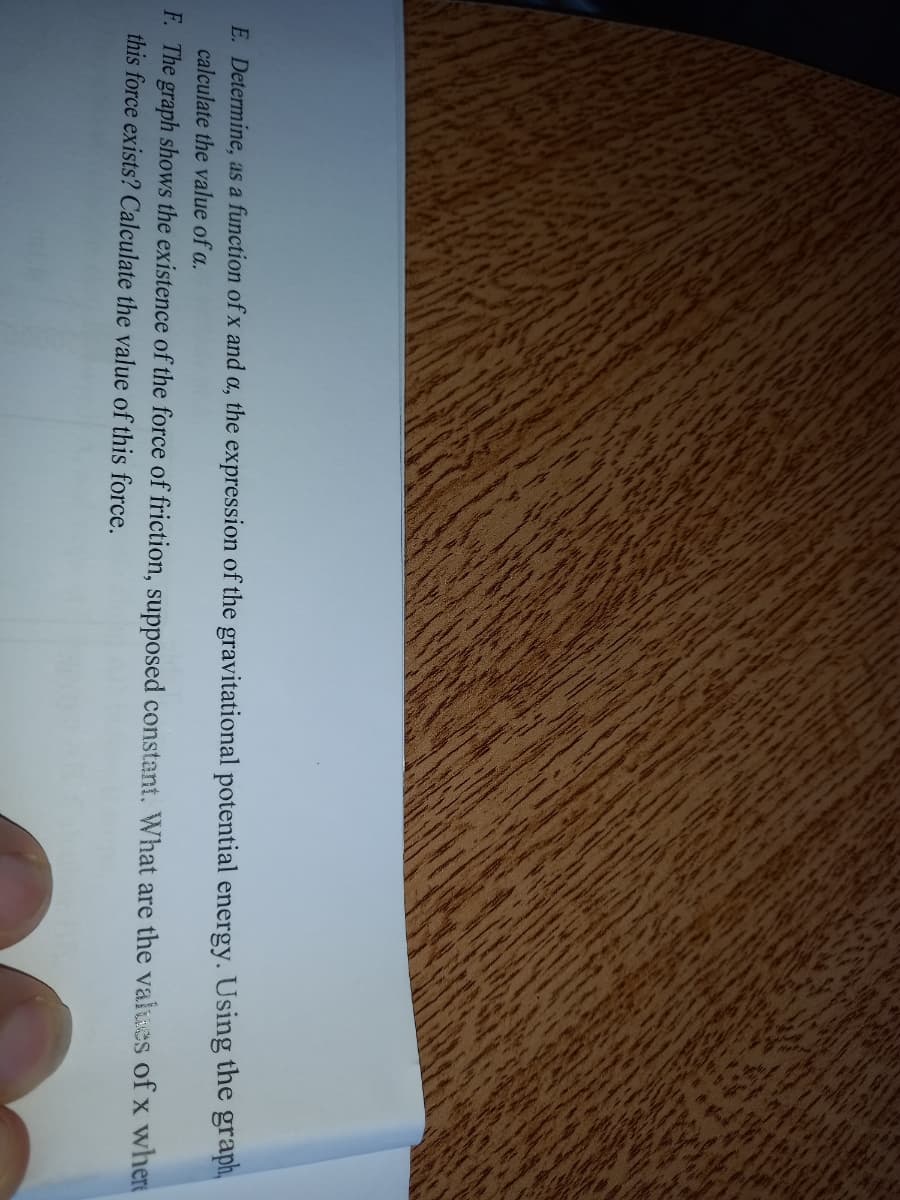Exercise 8: We launch, on an inclined plane and with a speed V parallel to the line of greatest slope, a solid (S) of mass m-100g (see Figure (a)). Knowing that x is the distance separating the launching point and the position of (S) at a given instant. In figure (b), we represent the graphs of the mechanical energy Em and the gravitational potential energy EPG of the system [(S), Earth]. Figure (b) Figure (a) E(J) 0.25 Em 0.2 0.15 Em 0.1 EFG 0.05 G.P.E reference 30 60 90 120 150 x(cm) A. Is the mechanical energy of the system [(S), Earth] conserved? Why? B. Find the value of the mechanical energy at the instant of launching. Deduce the value of Vo. C. Calculate, using the graphs, the speeds of (S) when x-75cm and when x-150em. D. The graph shows that (S) climbs but doesn't descend. Why? |Page
Exercise 8: We launch, on an inclined plane and with a speed V parallel to the line of greatest slope, a solid (S) of mass m-100g (see Figure (a)). Knowing that x is the distance separating the launching point and the position of (S) at a given instant. In figure (b), we represent the graphs of the mechanical energy Em and the gravitational potential energy EPG of the system [(S), Earth]. Figure (b) Figure (a) E(J) 0.25 Em 0.2 0.15 Em 0.1 EFG 0.05 G.P.E reference 30 60 90 120 150 x(cm) A. Is the mechanical energy of the system [(S), Earth] conserved? Why? B. Find the value of the mechanical energy at the instant of launching. Deduce the value of Vo. C. Calculate, using the graphs, the speeds of (S) when x-75cm and when x-150em. D. The graph shows that (S) climbs but doesn't descend. Why? |Page
Elements Of Electromagnetics
7th Edition
ISBN:9780190698614
Author:Sadiku, Matthew N. O.
Publisher:Sadiku, Matthew N. O.
ChapterMA: Math Assessment
Section: Chapter Questions
Problem 1.1MA
Related questions
Question
Can u solve the entire question for me
![Exercise 8:
Direction
of motion
me100g (see Figure (a)). Knowing that x is the distance separating the launching point and the position of (S) at
a given instant. In figure (b), we represent the graphs of the mechanical energy Em and the gravitational potential
energy EPG of the system [(S), Earth].
function
of x
cant.
Figure (b)
E()
Figure (a)
0.25
Em
0.2
0.15
Em
0.1
tical spring
EFG
0.05
height of
G.P.E
reference
30
60
90 120 150
x(cm)
A. Is the mechanical energy of the system [(S), Earth] conserved? Why?
B. Find the value of the mechanical energy at the instant of launching. Deduce the value of Vo.
C. Calculate, using the graphs, the speeds of (S) when x-75cm and when x-150cm.
D. The graph shows that (S) climbs but doesn't descend. Why?
|Page 6
JPages
We launch, on an plane and with a Vo to the line of slope, a solid (S) of mass](/v2/_next/image?url=https%3A%2F%2Fcontent.bartleby.com%2Fqna-images%2Fquestion%2Ffb6aa28c-c84e-4499-ae79-c368a2e61feb%2F582ff1af-4f34-4a4a-8dfd-8e5f09b283ed%2Fecw9sng_processed.jpeg&w=3840&q=75)
Transcribed Image Text:Exercise 8:
Direction
of motion
me100g (see Figure (a)). Knowing that x is the distance separating the launching point and the position of (S) at
a given instant. In figure (b), we represent the graphs of the mechanical energy Em and the gravitational potential
energy EPG of the system [(S), Earth].
function
of x
cant.
Figure (b)
E()
Figure (a)
0.25
Em
0.2
0.15
Em
0.1
tical spring
EFG
0.05
height of
G.P.E
reference
30
60
90 120 150
x(cm)
A. Is the mechanical energy of the system [(S), Earth] conserved? Why?
B. Find the value of the mechanical energy at the instant of launching. Deduce the value of Vo.
C. Calculate, using the graphs, the speeds of (S) when x-75cm and when x-150cm.
D. The graph shows that (S) climbs but doesn't descend. Why?
|Page 6
JPages
We launch, on an plane and with a Vo to the line of slope, a solid (S) of mass

Transcribed Image Text:E. Determine, as a function of x and a, the expression of the gravitational potential energy. Using the graph,
calculate the value of a.
F. The graph shows the existence of the force of friction, supposed constant. What are the valses of x wher
this force exists? Calculate the value of this force.
Expert Solution
This question has been solved!
Explore an expertly crafted, step-by-step solution for a thorough understanding of key concepts.
Step by step
Solved in 3 steps

Knowledge Booster
Learn more about
Need a deep-dive on the concept behind this application? Look no further. Learn more about this topic, mechanical-engineering and related others by exploring similar questions and additional content below.Recommended textbooks for you

Elements Of Electromagnetics
Mechanical Engineering
ISBN:
9780190698614
Author:
Sadiku, Matthew N. O.
Publisher:
Oxford University Press

Mechanics of Materials (10th Edition)
Mechanical Engineering
ISBN:
9780134319650
Author:
Russell C. Hibbeler
Publisher:
PEARSON

Thermodynamics: An Engineering Approach
Mechanical Engineering
ISBN:
9781259822674
Author:
Yunus A. Cengel Dr., Michael A. Boles
Publisher:
McGraw-Hill Education

Elements Of Electromagnetics
Mechanical Engineering
ISBN:
9780190698614
Author:
Sadiku, Matthew N. O.
Publisher:
Oxford University Press

Mechanics of Materials (10th Edition)
Mechanical Engineering
ISBN:
9780134319650
Author:
Russell C. Hibbeler
Publisher:
PEARSON

Thermodynamics: An Engineering Approach
Mechanical Engineering
ISBN:
9781259822674
Author:
Yunus A. Cengel Dr., Michael A. Boles
Publisher:
McGraw-Hill Education

Control Systems Engineering
Mechanical Engineering
ISBN:
9781118170519
Author:
Norman S. Nise
Publisher:
WILEY

Mechanics of Materials (MindTap Course List)
Mechanical Engineering
ISBN:
9781337093347
Author:
Barry J. Goodno, James M. Gere
Publisher:
Cengage Learning

Engineering Mechanics: Statics
Mechanical Engineering
ISBN:
9781118807330
Author:
James L. Meriam, L. G. Kraige, J. N. Bolton
Publisher:
WILEY